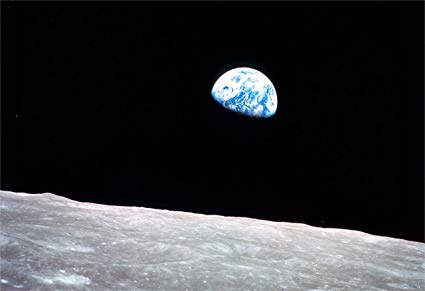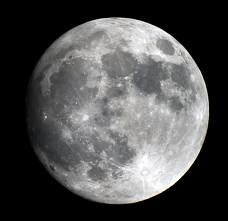
"Can anyone tell me where and when the moon will rise this evening?", he asked. We all knew the answer to the first part. Like the sun, the moon always rises in the east, and sets in the west. Thus we could point straight back through the rear window to where the moon was destined to rise. But although some of us may have recalled the time of the predicted eclipse, nobody knew what time the moon would first appear above the horizon. Except my father knew. He explained that the occurrence of a lunar eclipse meant that the earth had to be directly between the sun and the moon, so it could cast its shadow on the moon. That meant that, in order, the sun, the earth, and the moon had to lie on a straight line. If the sun, which we could see directly in front of us, was about to set, then the moon had to rise behind us at exactly the same time. The moon would be coming up behind us within minutes. And so it did. Note 1 I think that to many people, the statement that on the night of a lunar eclipse, the moon rises exactly at sunset would be a random fact that they would consider to be completely useless. But my father was not simply remembering a random fact. Rather, he had an overall picture in his head of the earth going around the sun, and the moon going around the earth, and an appreciation of how they had to line up with respect to one another if the earth were to cast a shadow on the moon. In other words, understanding the "big picture" enabled him to derive from it other pieces of information.
The fact that the moon is a celestial body over 385,000 kilometers (239,000 miles) away, rather than a person 3 meters away, is irrelevant. As you may know, you don't need to change the exposure setting of a camera depending upon the distance of a subject illuminated by sunlight. The exposure is the same regardless of distance. The same goes for the moon. Once this has been explained, it seems incredibly obvious - why should the moon be any different from anything else? Note 2 Here's my point: when you understand the "big picture", you know the answer to all sorts of smaller questions without having to learn those answers individually. Having learned that from my father, it served me well during my entire life. It perhaps explains why I want to know how everything works. When you have a basic understanding of how something works, you know the answer to hundreds of questions about that object that might arise. And you don't have to learn all those answers separately. Good examples of this principle abound, and particularly in science and mathematics. If you understand the basic principles of applied mathematics, for example, it turns out that there are only a few things to learn. All the details follow easily from a handful of basic principles. But to those who don't manage to achieve an understanding at a basic level, mathematics seems to be a collection of thousands of unrelated facts and formulas, all of which have to be separately memorized. Sir Arthur Conan Doyle's fictional detective Sherlock Holmes thought that our brains have a limited capacity for memory. He wanted to try to forget that the earth goes around the sun, because he thought this to be a useless isolated fact, with no meaning for his work fighting crime. But in this, I think he was entirely wrong. An understanding of the configuration of the solar system eliminates the need to remember thousands of things that would otherwise appear to be independent facts, and some of these are bound to be of use even to a consulting detective. I love all the Sherlock Holmes mysteries, but on this point, I think Sherlock missed the boat. My endless quest to understand how everything works often seems odd to those who don't share my point of view. When my sister Alice suggested that she might write what turned out to be my first "guest blog entry", she called it "Ask Larry". I introduced it with the words, "Do I know everything?" Of course I don't, even though some people seem surprised when they ask me a question and I answer, "I don't know." I only recently discovered that some people at the Kronos Corporation, where I worked for nearly 25 years, played a game called "Stump the Krak", to see if they could find a scientific or mathematical question that I couldn't answer. Since he understood how most things worked, my father also wanted to personally fix anything in the house that broke. He also taught me the art of repair, allowing me to help him, and then watching me as I worked under his tutelage. Many years later, I tried to do this with my own children, with mixed success. It turns out to be very difficult to watch a child slowly and laboriously doing something that you could do yourself in much less time, without succumbing to an almost irresistible temptation to jump in and do the job yourself. I began to appreciate my father's patience. Note 3 My mother didn't always appreciate my father's desire to fix everything himself, and never call in a repairman (in those days, repair people were always men). For example, when the fill valve in the toilet of our guest bathroom broke, my father repaired it. He somehow used a piece of aluminum cut from an old Coca-Cola can (I don't remember exactly what was wrong, or what he did with the piece of can). The fix turned out to be imperfect, and it broke again and again. Each time, my father repaired it again, refusing to call anyone in to do a better job, or even to just replace the entire fill valve with a new unit from a hardware store. Not long after my father died, my mother called in a plumber and had the entire toilet replaced. I deeply internalized my father's outlook on life. I am truly my father's child. To my mind, this is our only immortality. I was reminded of my father's photographic advice in December, 2018, while watching an episode of the PBS TV show Nova about the Apollo 8 mission, entitled Apollo's Daring Mission. Note 4 In the Nova episode, the narrator notes, "Assigned to photograph future landing sites on the moon, Bill Anders is stunned by something else that's completely unexpected." Apollo 8 astronaut Bill Anders is then interviewed, saying:
The Nova narrator then continued, "That picture is probably the picture of the century." Had I been on board Apollo 8, I could have instantly told Anders the proper exposure setting. Both the Earth in the distance and the moon in the foreground are simply objects in bright sunlight. Here's the famous photo, which has been called "Earthrise":    Note 1: If you want a really accurate picture, of course, you have to understand that the sun is not really "setting" and the moon is not really "rising". Rather the earth, between the sun and the moon, is rotating (from west to east). The sun appears to "set" and the moon appears to "rise" because we are rotating around to the dark side of the earth, dark because it's away from the sun, and, on the night of an eclipse, facing the moon. The sun, earth, and moon are roughly in a straight line not just on the night of an eclipse, but in fact for every full moon. But on the night of an eclipse, the straight line is close to exact, and the moon will rise precisely as the sun sets. [return to text] Note 2: Why doesn't the exposure needed for an object in bright sunlight change as it gets farther away from the camera? The total amount of sunlight reflected from the object drops off as the square of its distance. But the total area of its image on the film also goes down as the square of the distance, so the average amount of light per unit area on the film remains the same. At this point, young people are saying, "Film?" Okay, for the word "film" simply substitute "digital image sensor", and you will have updated this footnote. It's important in the above that the sun is very far away, about 150 million kilometers, or 93 million miles, on the average. Thus as an object gets farther away from your camera (with the sun at your back), it's not getting much farther away from the sun, percentage-wise. Hence the amount of light falling on it is not measurably reduced. The situation is quite different for a night photo, in which the light comes from a flash near the camera lens. In that case, the exposure setting very much depends upon the distance of the subject from the camera. It's always amusing to see thousands of flashes going off in the stands during sporting events. Beyond ten meters or so, a flash is useless. [return to text] Note 3: Many of you will recall the famous Mark Twain quote, "When I was a boy of fourteen, my father was so ignorant I could hardly stand to have the old man around. But when I got to be twenty-one, I was astonished by how much he'd learned in seven years." [return to text] Note 4:
Nova, "Apollo's Daring Mission", season 45, episode 17, aired December 26, 2018. Written and produced by Rushmore DeNooyer, and narrated by Jay O. Sanders. Executive Producer Paula Apsell. To buy a copy of the program, visit https://ShopPBS.org [return to text]
 |
 Before dipping down into the Queens Midtown Tunnel to cross under the East River, the Long Island Expressway offers a spectacular view of the New York City skyline, as shown in the picture to the left. I recall the entire family being driven into Manhattan one evening, perhaps to see a play or concert. The sun was just about to set in the west, directly in front of us (it's not shown in the picture). There was another special event scheduled for that evening: a total eclipse of the moon. Thus while driving, my father, Daniel David Krakauer, was talking about the moon.
Before dipping down into the Queens Midtown Tunnel to cross under the East River, the Long Island Expressway offers a spectacular view of the New York City skyline, as shown in the picture to the left. I recall the entire family being driven into Manhattan one evening, perhaps to see a play or concert. The sun was just about to set in the west, directly in front of us (it's not shown in the picture). There was another special event scheduled for that evening: a total eclipse of the moon. Thus while driving, my father, Daniel David Krakauer, was talking about the moon.
 As it happens, this was not the only time my father surprised me with a "big picture" answer relating to the moon. I found myself one evening wanting to take a picture of a particularly beautiful full moon. When I was a child, cameras had no light meters, nor would I have trusted one to give me an accurate exposure for a small bright moon in an otherwise black sky. I asked my father for advice. What exposure setting should be used for the moon? I didn't think he would have an answer to what I thought of as a rather exotic question. But he did, because he once again returned to first principles. What is the moon? Well, it's a gray object illuminated by bright sunlight. So the proper exposure setting was exactly the same exposure you would use to take a picture of a person on a sunny day.
As it happens, this was not the only time my father surprised me with a "big picture" answer relating to the moon. I found myself one evening wanting to take a picture of a particularly beautiful full moon. When I was a child, cameras had no light meters, nor would I have trusted one to give me an accurate exposure for a small bright moon in an otherwise black sky. I asked my father for advice. What exposure setting should be used for the moon? I didn't think he would have an answer to what I thought of as a rather exotic question. But he did, because he once again returned to first principles. What is the moon? Well, it's a gray object illuminated by bright sunlight. So the proper exposure setting was exactly the same exposure you would use to take a picture of a person on a sunny day.